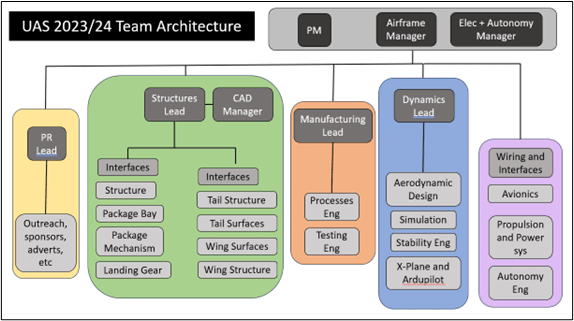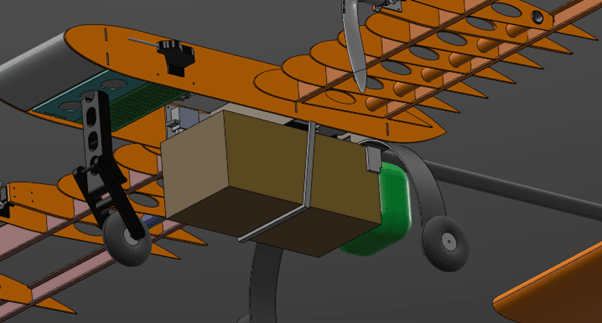Team Aeronottical: IMechE UAS Challenge University of Nottingham
Follow articleHow do you feel about this article? Help us to provide better content for you.
Thank you! Your feedback has been received.
There was a problem submitting your feedback, please try again later.
What do you think of this article?
Our student-led team is taking part in the IMechE Unmanned Aerial System (UAS) Challenge for the 23/24 academic year. We are designing, building, and testing a 10kg UAV that is designed to complete specific mission objectives set by the IMechE. The UAV must autonomously perform several tasks on the test day in July such as navigating waypoints, accurately dropping the Aid Package and returning to base via a defined route. The project not only aims to build a UAS and develop student’s technical skills but also to help students from different degrees connect over similar interests. This not only drives their success but also contributes to the development and supply of new engineers to the industry, made all the more possible due to the challenge’s close ties with big Industry partners such as Leonardo and PA Consulting.
Objectives
While participation in this competition is our day-to-day objective, we are also aiming to establish a long-lasting team at the university so that students can enjoy this opportunity for years to come. This is only the second year the challenge has been attempted at Nottingham, the project began in September 2023 with 11 members from last year and approximately 26 new students from various degree programmes. Commitment has floated between 20-25 members attending weekly meetings, showing a massive improvement to the previous year. We hope that the faculty will continue to support our team to keep it running in the future.
Methodology
Current Progress
The project is almost reaching the end of the detailed design phase. In the coming weeks, the team will sit through a critical design review (CDR) where University faculty will scrutinise and feedback on the work conducted by the team. Following this review, the team will begin manufacturing with several sub-system tests being conducted on the wing spars, package release mechanism and landing gear to verify that mistakes made last year are no longer present.
Current objectives revolve around finishing our 3D model of the aircraft to facilitate manufacturing in mid-March. Additionally, final preparations are being made for the CDR presentation which will be used on the 5th of March to communicate our design to university staff. In conjunction with this, another 3d model was developed to simulate the flight and mission performance in X-plane 11.
Team Structure
Our team is consisted of undergraduate students from various degree programmes (mainly aerospace) with students from year 1-4. The team is divided into several sub-teams whose main objective is to deliver the main components of the drone. The wing and tail team design, you guessed it, the wings and the tail which involves the initial conceptual design all the way to the drawings and build guides used during manufacturing. Likewise, the fuselage team do the same for the fuselage, landing gear and package release system.
Design Strategy
This year’s UAV has been designed with low cost and ease of manufacture as the main focus. The previous years attempt suffered from a long-drawn-out manufacture stage that did not allow enough time for the team to re-work issues that cropped up following the initial flight test. This year a much simpler design will enable rapid manufacture and maximise time spent flight testing (and repairing).
Design Overview
We have chosen a fixed wing platform to maximise efficiency and to build on skills and experience present within our team. The UAV will disassemble into 5 main components (with 2 carbon fibre tubes slotted through the fuselage):
- 2x Wings
- Fuselage (with landing gear attached)
- Tail Boom
- Tail plane (vertical and horizontal as one)
This allows for easy transport of the UAV while not compromising on the required rapid deployment needed for the mission. We are using the open-source software Ardupilot to control the drone from a laptop ground control station (GCS). This allows route planning and telemetry monitoring from the ground.
Products
The goal this year is to conduct additional testing of sub-systems and critical structural components before the first test flight day. With the additional financial support, the RS Grass Roots student project fund has provided us, our team will be able to finance test rigs and gain insight into the validity of our design decisions. With these tests in our capability, any re-work that may need to be conducted will be discovered much earlier in the design cycle, enabling the team to meet deadlines and ensure the highest probability of success within the competition.
We are interested in the range of FDM 3D printing filaments available which would work well for our testing rigs as well as many components that will end up on the UAV such as interfacing brackets and the front landing gear. Additionally, we would like to use the fund for purchasing standard parts (fasteners, springs, bearings) to use in our package release mechanism and the front landing gear.
This will allow our team to maintain the deadlines that we set and keep our project on track. We hope this will lead to our aircraft seeing sufficient testing time at the end of the project which will give us confidence that it can perform on the final testing day in front of the IMechE. After not making it to the test day last year, the support of the RS Grass Roots student project fund has boosted our team’s morale as we try for the second time to make our drone fly at the IMechE UAS challenge this July!
Next Steps
Our next steps following our CDR will be to finalise the 3D model, prepare manufacturing drawings and build the UAV. With the completed product we will conduct flight testing to identify any re-work that is needed and begin to certify that our aircraft can meet the competition requirements. A fast build stage will ensure that we have sufficient time for this and was a challenge last year. Getting the build done fast will not be easy but the mistakes made, and lessons learned from last year will give our team an advantage this time around.
Our project will be considered a success when we have seen our UAV landing after dropping its 5kg aid package in front of 300+ students and volunteers at the IMechE UAS challenge fly off this July. We want to set the stage for future students to compete from our university and this victory is exactly what we need to make that a reality.
Media
The UAV CAD model is approaching maturity with a few details left to add. Construction is primarily birch plywood with spruce used for spars. Skin is made from 5mm hobbyist foamboard and CFRP tubes are used where high strength and stiffness is required.
Written by Lily Saysell, Harry Stringer, Alex Harlen and Hamidullah Nasery





